Multimodal Scholarship Showcase
An interactive showcase of research and scholarship from the Teachers College community
April 16, 2025 — Smith Learning Theater
Panelists:
Beth Rubin, Professor of Social Studies Education, Teachers College, Columbia University
Rachel Talbert, Lecturer in Early Childhood Education, Teachers College, Columbia University
Jacqueline Simmons, Senior Lecturer and Vice Chair in the Department of Curriculum and Teaching, Teachers College, Columbia University
Sarah Gerth van den Berg, Visiting Scholar at the Digital Futures Institute, Teachers College, Columbia University
Moderator:
Lalitha Vasudevan, Vice Dean for Digital Innovation, Teachers College, Columbia University
Remarks have been lightly edited for length.
Lalitha Vasudevan
What we're trying to do, with not only this showcase and this kind of broad invitation to engage with these projects, but also with a strand of work here at Teachers College that we put under the umbrella of multimodal scholarship is to think about: What new ways of understanding the world, understanding the lives of people with whom we live, understanding the questions that we have, what are new ways to go about doing that? With the advent of new goals, new technologies, new practices?
And so this question at its core around multimodal scholarship is really driven by a desire to get an even more robust understanding. And not to say that we're going to get a perfect piece of information, the perfect knowledge, the perfect kind of story. But to say there are other stories that we get to be told.
And how do these tools and approaches help us get closer to that?
We have on the panel, colleagues who are really doing a wide ranging work. These projects took different forms, and they came to light as a result of a few different fellowship opportunities that the Digital Futures Institute put forth. We were really moved by the proposals for these projects, and that's how we were so fortunate to work with them.
Let’s start with you, Beth. Would you say a little bit about the work that you're engaged in?
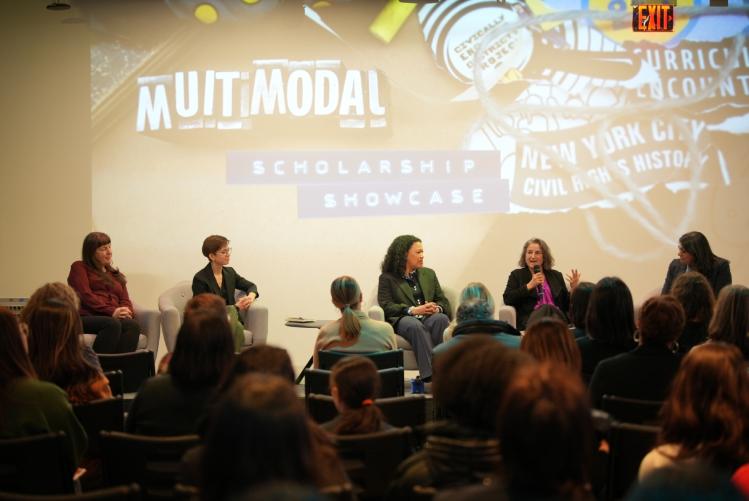
Beth Rubin
I am a professor of social studies education. My focus is on youth civic learning and I do a variety of research. But the particular project that brings me here today is the Civically Engaged Districts project, which is a community engaged research project where we work with educators and young people on integrating youth participatory action research into social studies and other classrooms.
And it's work that I've been involved in for over 15 years, mostly in the state of New Jersey, and now in New York. [We’re] really trying to think more expansively about what civic engagement means, what it looks like, and to reconceptualize young people as not as citizens in training, but citizens of the now. So acknowledging the idea that young people are actually active in the moment, in their schools, in their communities, in their families, that's the kind of civic learning that oftentimes makes an impression on them and feels most meaningful to them.
And so our work is really supporting teachers to create practices that allow those things to come into the classroom. And for years we've seen these projects, we've seen the incredible work that young people do, the really thoughtful, sensitive work that educators are doing. And we can talk about it, and write about it, you know, and I'm sure I've written about it ad nauseum, but there's nothing like actually seeing it. And, you know, photos are powerful but the video material is so, so powerful.
Lalitha Vasudevan
[joking] Beth answered the second question already. (laughter) But it’s a good preview. I’m going to go to Rachel. Can you say a little bit also about what your area of work is? And maybe talk a little bit also about what invited you to respond to this call?
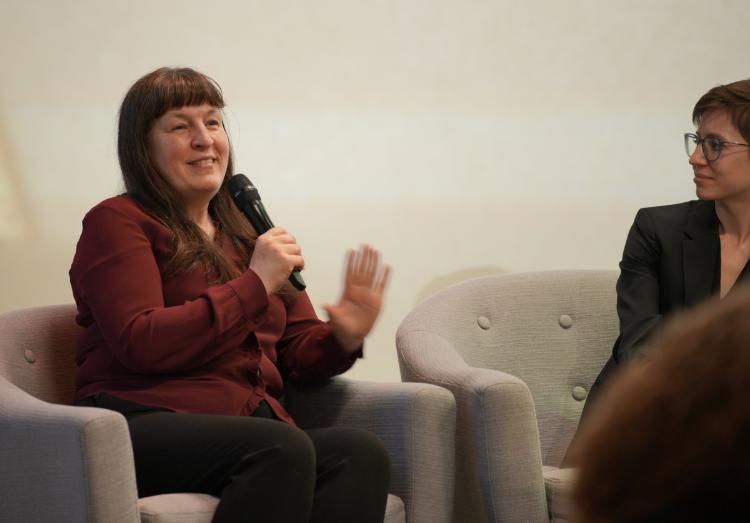
Rachel Talbert
What brings me to this work is I had coffee with a Lenape elder and co-founder of the Lenape Center when I got to TC in 2021, and he said, “Do you know anyone in the Curriculum and Teaching department who could do curriculum with us?”
And I said, “I’m in the Curriculum and Teaching department, and I will do the curriculum with you.” Since then, the partnership has grown. We have a K-12 curriculum and this particular piece of the curriculum is for middle school.
And the school is so important as what brings us to this work is actually social sciences textbooks, and social studies curriculum, which by and large still teach in New York, New Jersey and Pennsylvania that the Lenape are mostly gone, and that they sold the island of Manhattan for trinkets. And we know that’s not true.
So having multimodal scholarship really matters because we're combating decades of people learning things in textbooks, decades of people being taught things by teachers, and we have to do it in a way that story-tells well and is attractive to people.
And so this project, Learning with the Lenape, is helping us learn from Lenape voices instead of just about them, and we’ll have five more Lenape elders involved in the project before it’s done.
I think multimodal scholarship is maybe the only way, because we're not going to bring everyone back through all of their K-12 social studies, nor are we going to get people to read lots of books in today’s “attention” society. So it’s a lovely way of doing learning for the public, public pedagogy, as well as K-12.
Lalitha Vasudevan
I appreciate that, and I think one of the linkages between what Beth was saying and what you offered was inviting this new form to expand work that you have been cultivating for a while, and finding new audiences through this new expression and new form.
Sarah and Jackie,what brings you to this work, and what led you to respond to this call?
Jacqueline Simmons
I think of our podcast as sort of a class, of the kind of class that we hope that you want to sit in and you're waiting for the next one very avidly, because Curriculum Encounters is sort of a byproduct of a lab that I started with Professor Emerita Nancy Lesko in 2018. It’s called the Black Paint Curriculum Lab, and that came out of conversations that we were having with some students about how these dialogues that we have about critical theories and readings never really have a place to go. The class ends and you’re still a little on fire with the conversation, what can we do with that?
And so we had this “lab” space where we could have activities. And Sarah joined us pretty quickly and we made this a weekly, it's almost like an after school club here at TC . Faculty, alum, and students would join together for an hour to engage in some kind of, really, curriculum encounter. And then we go off and we, we do our work, we do our research, our readings.
We kind of hit our sweet spot in the pandemic because we could no longer meet weekly, but our audience kind of blew up. We had more people participating via Zoom. And so then when this opportunity came around, to think about other formats, we thought about podcasts. (Maybe you want to pick up there, Sarah.)
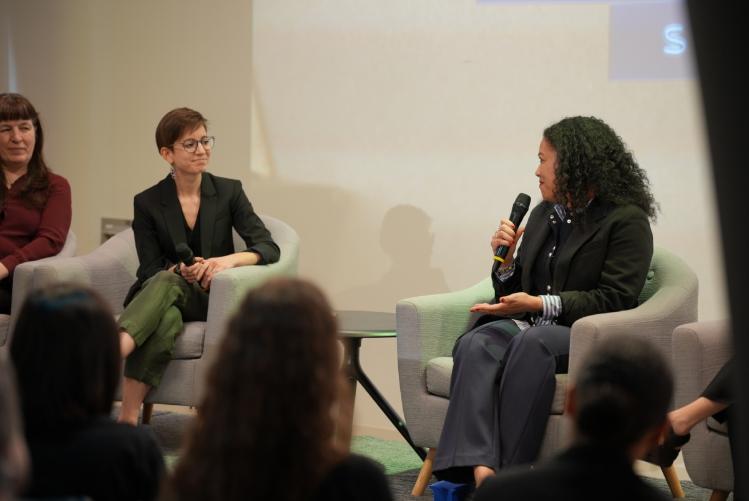
Sarah Gerth van den Berg
It was really neat to think about: What does it mean for an “after school club,” Black Paint, this lab where we experimented with different forms of curriculum, to be this audio format? And what does that really do as a way of producing knowledge? Together through the whole process and the invitation to approach it as multimodal scholarship, at each stage, thinking about the idea as collecting the data or the sounds, going back and editing–it was such a meaningful part of that process.
And then I also recently have been going back to an advisor on my dissertation, which took place at Black Paint, Nathan Snaza, talking about having writing produce the effects it was trying to study, and that's not always appropriate. But when it is appropriate, how can the very form of scholarship produce some of the effects it's studying? And I think through podcasting and through kind of playing with audio and experimenting with that, how can we invite listeners with us to think about curricular possibilities in different ways and to encounter knowledge in different spaces, kind of along with us?
Lalitha Vasudevan
All of you have also touched on this idea of scholarship intentionally. Look, all of us sitting here have done dissertations, we've done research. What it was like to engage in conventional scholarship in these modes? We have two video projects, one audioproject.
Jacqueline Simmons
I was initially surprised at how much it felt like traditional research. You still have your inspiration from ideas that are in readings that you've been talking about with colleagues. And you use that as a way to form a question. A great question leads you to some investigation to try to understand it better through additional research, through some kind of other investigation you create, or you select your methods.
And our method happened to be, as Sarah explained, this iterative one of dialogue, of exploration in spaces and looking at materials and bringing listeners along with it. So it might sound like we're kind of scripted in the podcast, but we're actually not a lot of the time. We actually are just having a dialogue, having a conversation. That's one way I think it's been interesting.
Rachel Talbert
Thinking about how this is the same or different from your dissertation, you still have to do a ton of research. I've read so many documents, like from the Holland Society, the Dutch historical society, and land deeds. There are so many different accounts to get to where we are. Pretty much everything the Lenape Center said: read, I read.
It was just like when you're doing any research, you read those and then you find out how much you don't know, so then you have to read even more. So it was the exact same amount of research.
But what I appreciate about the multimodal scholarship is the ability to transcend the idea that you're going to write something that's for just a very small field, hopefully beyond your committee, but usually just a community, and maybe a couple other people who read it, maybe it becomes articles.
I'm thinking about when I asked my advisor, “Oh, I want to show people this.”
“Well, do an APA table or you can have a photo.” This is so much different and thicker and richer than an APA table or a photo, and it doesn't have a paywall on it. It doesn't require you to log in to single sign on libraries to get to it. And people actually want to engage with it.
And not to knock anyone's scholarship, but I think a lot of times you hand people in the public a 30 page journal article and they're like, “Well, so what? I don't want to read this.”
Whereas with multimodal work, everybody wants to watch, view, and learn. And I think it's a great way that universities can really be part of a public and societal good right now when people are asking these questions about: What are universities doing? I think multimodal scholarship is one way to share that knowledge much more openly with the public and make it more immediately useful in the public.
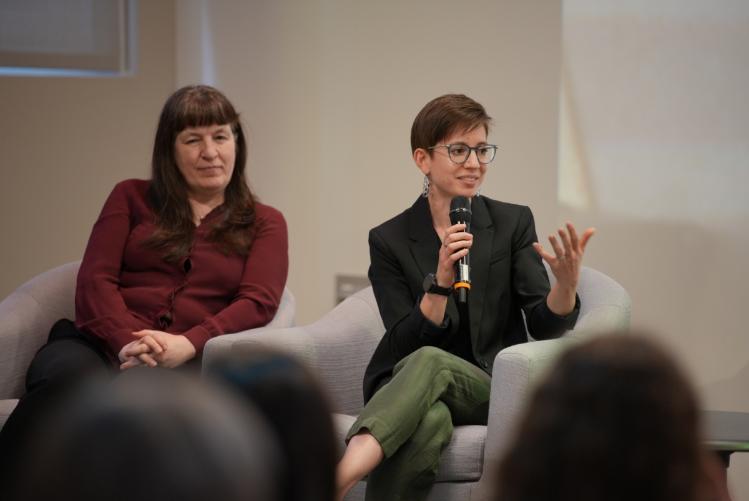
Sarah Gerth van den Berg
Those are great points on expanding audience and access. And I was thinking on the other side of that, what multimodal scholarship does for authorship has been really exciting. As much as there are efforts (and good ones) to coauthor written work and expand the ideas of authorship in written work, it just still feels so much harder to do.
The collaborative nature of producing knowledge in a podcast or multimodal scholarship just feels so different. It feels so much more natural and open and just that we could do the work together and coauthor in that way.
Lalitha Vasudevan
I also really appreciate how you are thinking about audience, and who is reachable with these new modes. You also touched on the process. What was it like to collaborate with media producers, to have done that research, and then to engage in these practices of co-production?
I think it would be really helpful for people who are thinking about the translation and translation of it into different modes.
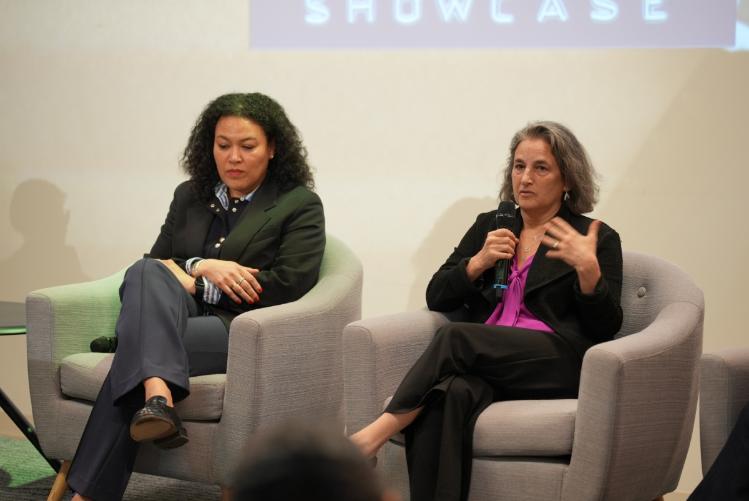
Beth Rubin
In my project, the [DFI media] team came out to schools in New Jersey on two days, and we had teachers and students and administrators presenting their work and being interviewed.
And it struck me, as you go through that process and then looking at transcripts and seeing which pieces went where, just how much that process was like the process of qualitative inquiry where you're kind of, as they say, stepping into a real reality box. There's life happening all the time, and if you're doing research, you're stepping in at one particular moment, capturing this piece and trying to make sense of it. And that was what was happening in these projects.
It was exciting to see a whole other set of expertise doing a similar thing, but in a different field.
And then the process for our young people and educators also was very powerful. There's a group of kids who have been asking me every time I see them, when is the video? And it just came out and they're just over the moon, they're thrilled. For the kids and the teachers, seeing the work that they're doing from a little bit more of a distance perspective and seeing what it looks like to have a number of people speaking what they've been doing and the work across different contexts, it has been really empowering. Everything's visual today in our society, and if they want to share what they're doing, it's a lot easier for them to share a video with family or with colleagues than other kinds of media.
Lalitha Vasudevan
It's interesting to mark this, what Beth said about how expertise lives side by side, you have media expertise alongside research expertise, and the experiential expertise from the young people.
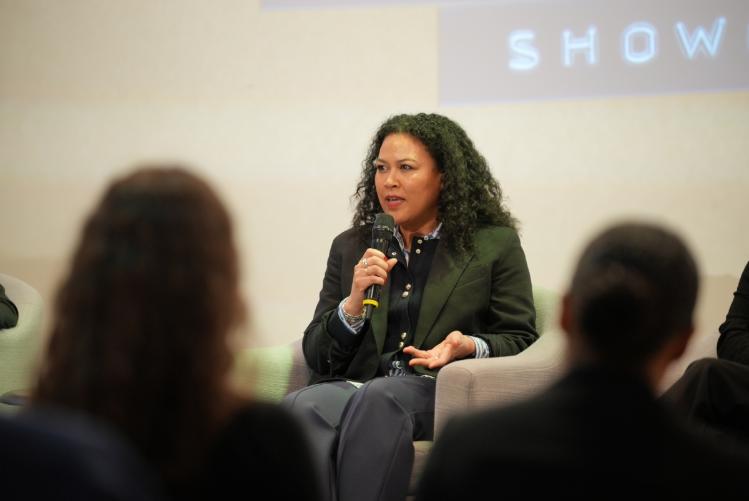
Jacqueline Simmons
And so that's almost exactly where I was going to go with this, because I was thinking about all of the expertise that we think we have, as some kind of expert in some field of knowledge. And then when you’re making media there really needs to be a space to put that in suspension a little bit, because media-making asks something else of knowledge. It requires a different orientation that is sometimes not how we hold the information that we have. It's not how I think about my field necessarily.
Having a media partner, producer, or somebody in the booth with you, actually bringing their expertise into thinking about: How does that sound? How do you want to communicate? How do you want to frame this story for the listening audience? It's really different. For us there had to be a collaborative negotiation, so that even though it’s our ideas and knowledge that we're putting out there and our voices, we're saying it, there's so much more in there that is shared in the presentation of that research.
And I think that's one of the greatest assets of working with DFI. I’ve made other media, I’ve helped produce films and, you know, film sets aren’t always like that. Great media collaborators are not always so generous. So this team, in particular, has been really helpful.
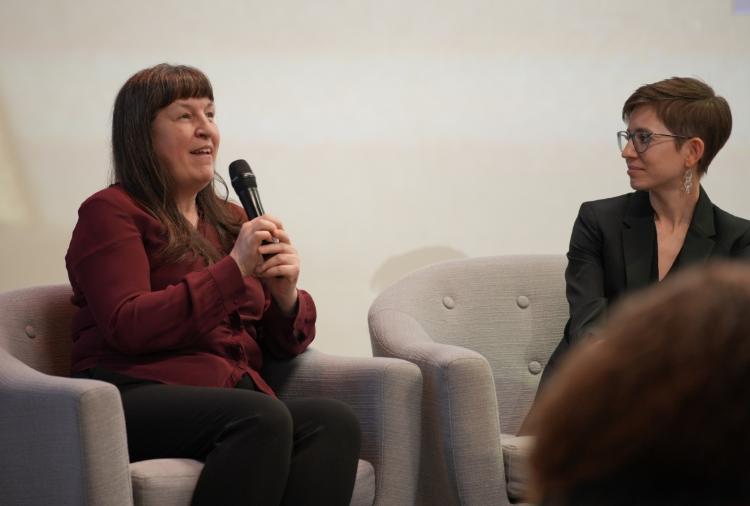
Rachel Talbert
I think I had an easier task because the Lenape center knew what they wanted for the curriculum. They gave me a list and then more things to read about each shot.
The more challenging thing was thinking about the why and the how, because when we did the shoot, it was like 6 to 7 hours in the city, in Manhattan and on a ferry, and on Governors Island. And so thinking about those shots, the story that they wanted to tell in the curriculum and seemingly things that would be very uninteresting–the shot of Wall Street (the sign), of Pearl Street (the sign), but knowing that both those things have really important connections to the Lenape.
Going to Governor's Island and seeing the chestnuts in the trees and on the ground, shots that without the stories, would be nothing. Working with the film crew made those things able to come to life in a way that I would have not imagined. So getting this shot all the way down Wall Street so you could see where the logs were still in the ground, to be able to tell that story in a more complete way, is something I wouldn’t have thought about. Filming the different angles of the ferry, making sure that we thought of the shot of the actual street grid of Manhattan, all things necessary to tell that story.
So it was good to have the list of things from the Lenape Center, but it really made me, and it's making the elders think about the stories differently because of all the different aspects we have on the film. Particularly Wall Street really stands out to me as something that we were thinking, oh, it's the sign and it's the street, but there's so much story in that archeological space of where you can see where the posts are–that's still there. You can see that very present wall where Lenape scalps were brought. You can see the traces of that still. And so it's a much more powerful story that would have been imagined by the Lenape Center or imagined by me because of the skills that the film crew provide.
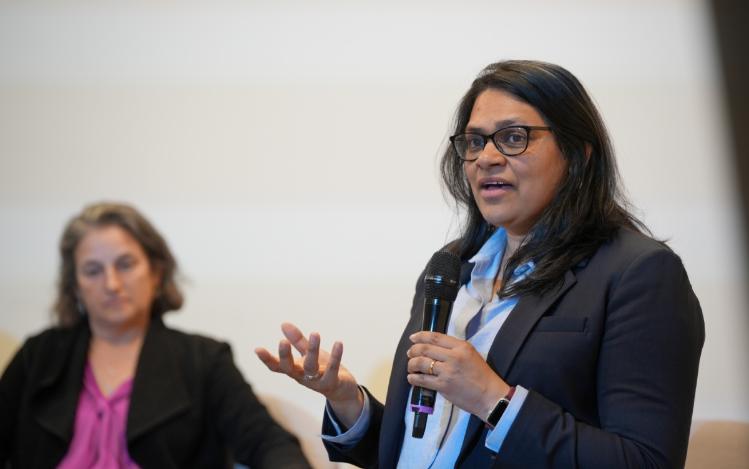
Lalitha Vasudevan
I appreciate that. And I'm going to wrap us up with one final question. I think about the aesthetic and communicative affordances of modes beyond writing. (And writing itself is so multifaceted, multi-genre, so we wouldn't want anybody to leave here thinking writing is not multimodal. Writing, of course, can be multimodal.)
There's something different, you all are saying, that happens when you take these animating modes and these other forms of media to do a different kind of work in the world.
Could you say where this work takes you? How do you see this particular piece of media living in the world, and how do you see it living in you moving forward?
Beth Rubin
We're just getting to scratch the surface of what I think we can do with this work. We do professional development with educators, and now that we have these videos that become part of the professional development, but then the videos are becoming part of the lessons that the teachers are creating for the classrooms.
So, say they're introducing their class to the idea of doing youth participatory action research, they're now showing videos of young people talking about their experiences with that work. They are being integrated into units and lessons as a tool. And then when we talk about the work in other places, it's a much more vibrant example of what it feels like and what it looks like than anything that we could say or write.
We have now nine videos and they're on our website and people are using them in all kinds of different ways. We're trying to kind of capture that and document it and then turn it around for other educators. So, here's the introductory lesson that integrates these videos. And we have that on the website so people can use that. It feels like a snowball where it kind of picks up speed and gets bigger as it goes. And really, it's only been a couple months, so I'm very excited to see where it goes.
Jacqueline Simmons
We just wrapped our first season and we're planning our second. I think our goal is that we want people to also have curriculum encounters wherever you are, wherever you go. Even if it's right now in this chair, to have some way of expanding the way you're thinking about knowledge.
Our first episodes take place here at Teachers College. We may need to model that a little bit more, so our next episodes are out in the world where we go on curriculum encounters so far to the supermarket, to ferry, the pier, and other places. We're taking your recommendations. It's leading us back to our book, which we had actually started several years ago with our own curriculum encounters. And maybe Sarah, you want to tell people about that?
Sarah Gerth van den Berg
Yeah, that is neat to think about how it's come back to feed into written scholarship, [which] is also multimodal, but the way it's just been able to spark conversations and connections.
Part of your question, Lalitha, is: How is that living in you now? It's been something I'm able to share with colleagues outside of TC as well, who are sort of like, “Oh, I get this now. And so you mean, when I'm in this other space: here's a way I might relate to the kinds of learning or knowledge or gathering that we're doing here?”
So that's been encouraging. And my dad has listened to it and is thinking about teaching archery differently. So I think just those little moments.
Jacqueline Simmons
And my sister is listening to it, which is the biggest thrill.
Rachel Talbert
In the short term future [these videos are] immediately useful for the middle school and high school curriculum. The younger students have had videos in the curriculum for the last two years. So the teachers of older students have been saying, “Where are our videos?” So they're coming.
Lenape Center's goal for a long time has been to have public pedagogy at important entry points to New York. So we are hopeful, and Joe Baker is hopeful, that we can get a QR code link to the story, site by site at the tip of Manhattan, that can be something that when you come to New York and you see the Statue of Liberty, you also learn about the Lenape from Lenape people who are alive today and see the spaces in real time.
And in the longer term, doing a similar project at the other end, in Inwood Hill Park in Manhattan, doing that sort of work there. And also, we're already excited, perhaps several years too soon, about doing the work in Philadelphia. So Lenape Land is also Philadelphia, which has its own story of Penn's Treaty and the walking purchase there, right on what is today known as the Delaware River.
And the story of trees there, and also the story of Joe's ancestor, who signed that treaty. So looking to do multimodal scholarship, perhaps on Lenape lands in Philadelphia in a while.
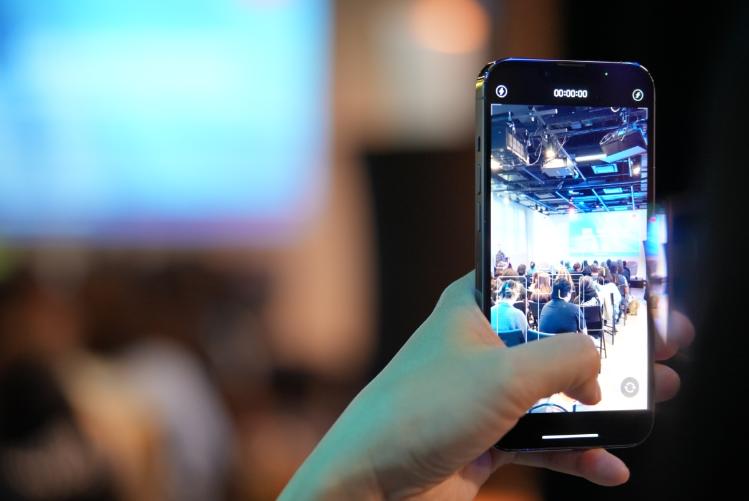
Lalitha Vasudevan
So first of all, thank you all for joining us and sharing your work and experience with us. I want to offer two other things for you to be thinking about and sitting with. Stories can move the world. The stories that emerge out of research can only do so if they are received and disseminated. But even more than being disseminated, we want to think about ways for people to engage with these stories and these realities that you're all exploring.
And so part of the work of not only the multimodal scholarship efforts, not only at DFI but across Teachers College, is to think about and create opportunities and conditions for people to encounter and engage stories much more intentionally. And hopefully that'll happen with many of you who are sitting here who might be pursuing doctoral work, who might be thinking about using different approaches to your scholarship.
We also have an exhibition upstairs. It's the second iteration, it's called MODES, and it's the brainchild of Chris Moffett and Lucius Von Joo. MODES celebrates multimodal dissertations that were already in the world, from people who either graduated from Teachers College, or Teachers College adjacent.
All around you tonight there are other examples of really wonderful, thoughtful, intentional pieces of scholarship that were produced with the intention of taking stories that matter to people, to a lot of people, and finding new audiences for them, hopefully in the spirit of having impact and change in the world.
You can help us by sharing it (apparently with family members, because that's who everybody here has shared it with) but also other people, because we want to keep helping people make this kind of work. And we are so thankful for your presence here. So thank you. Enjoy. Be well.